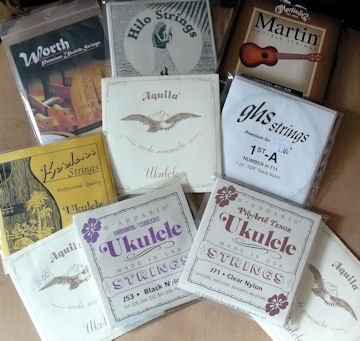
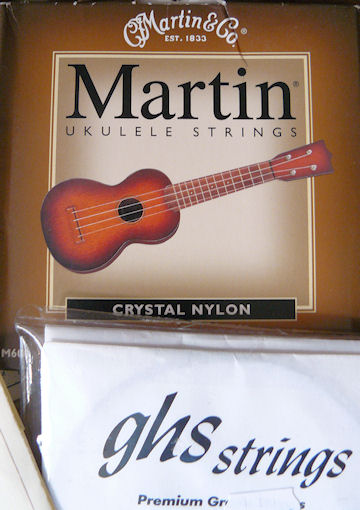
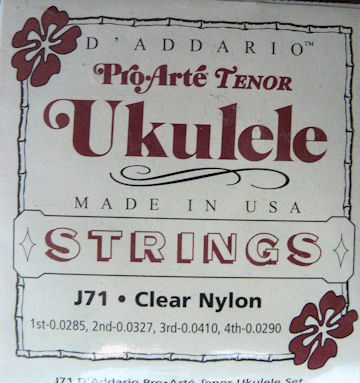




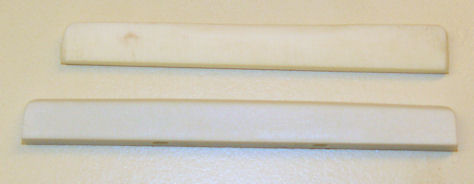



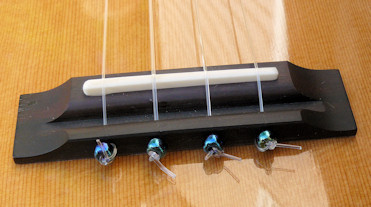

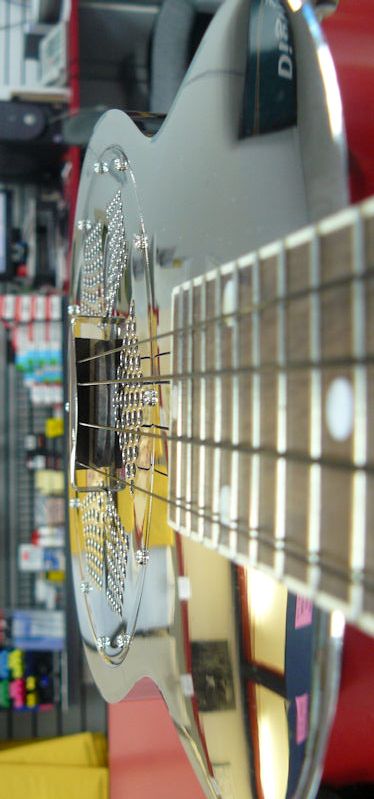
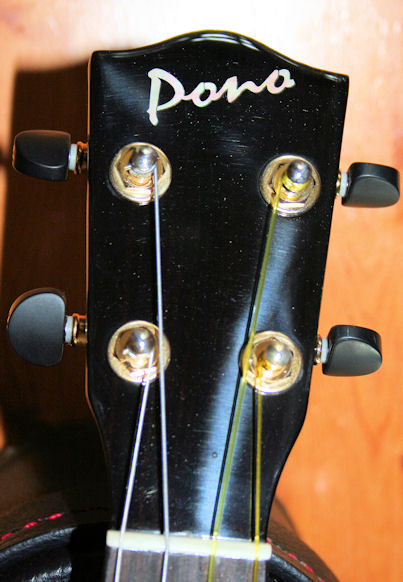

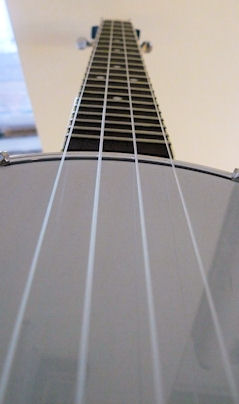

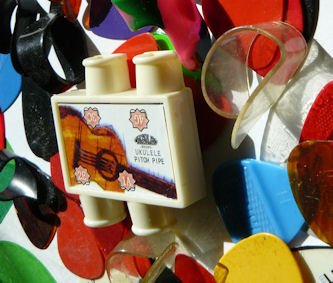
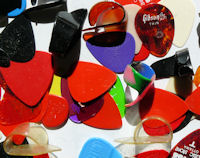

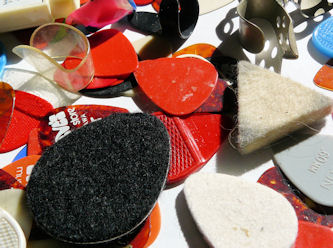
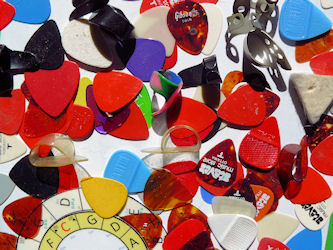
Strings and Picks
Strings are ornery topics for most uke players. You can start an argument (or to be civilized, a heated debate) among uke players by simply asking what strings they prefer. Uke players will also argue over the quality of various tonewoods, but perhaps not quite as readily.
Strings are also very personal and affect a player's style and expression. Brand loyalties rear their heads in discussion, too. Since no two wooden musical instruments are ever exactly alike, what sounds good on one may not on another, even another of the same brand and model.
Strings used to be made from gut, but now are made out of nylon (i.e. GHS, Ko'olau), nylgut (i.e. Aquila) or fluorocarbon (i.e. Worth). Each material has its own tonal qualities.
The low-G strings are usually wound (nylon wrapped in a metal - aluminum or silver - sheath, although Kala Reds are apparently nylon wound). Some manufacturers are also using a wound C and there are sets with both the G and C wound.
These wound strings produce a more mellow, mid-to-bass-oriented tone. However, wound strings can be harder on the fretboard and will wear down the plastic frets of some ukes (i.e. the Fluke). The winding also wears away when rubbing against the frets, and can cause wound strings to deteriorate faster.
Most ukulele strings are not steel, like a guitar. Putting metal guitar, banjo or mandolin strings on your ukulele adds a lot more tension and stress on the bridge (see below). It could rip the bridge right off! At the very least it will warp the top and possibly the neck. However, there are some ukes designed for steel strings- especially the solid-body electric ukes like Risa and Jupiter Creek.
In general, thicker strings have more tension, so they are louder, but can be a little more difficult to play and don't bend as easily as thinner strings (for new players, thicker strings can be more painful until the callouses grow in). Tenor strings have more tension than concert, which has more than soprano strings. Extra tension also improves volume.
Many Vaudeville performers preferred the D (A-D-F#-B) tuning because the extra tension on the strings gave the uke more volume and the higher pitch had more projection. This tuning is still popular in Nova Scotia. A lot of today's string sets can be used for either the C or D tuning.
Thinner strings are more flexible, but not as loud and sometimes prone to buzz on a uke with low action. Personally, I prefer a slightly heavier string for more projection and volume.
Long-necked ukes like the Ohana (tenor neck on a soprano body) need thinner strings for the lower tension to help prevent neck warping.
For resonator ukes, you may want thicker strings with more tension to transmit the most sound to the cone. My Republic came with thin GHS strings, which are probably fine on a wooden uke, but not the best choice for a reso, which needs the extra energy to develop its fullest sound. I changed them to heavier Aquilas and got a better, cleaner sound.
Overall, I prefer Aquilas for most ukes because of their volume and brightness, but again it really depends on the instrument and your own personal taste. I have also enjoyed D'Addario J71s (Pro Arte) on several ukes and while more mellow than Aquilas, they have a smooth texture that makes them easy to play. Worths are also good and have their loyal users.
In my own experience, all of the black strings I've tried have been too soft and too mellow for my taste, and I've replaced them with something else. That may not be true of the new Blackline strings, but I have yet to try them.
You can get an endless supply of opinions on string brands online, but be prepared to wade through many arguments over which is best. Since strings are relatively inexpensive, it's not a big investment to try a set for yourself. In fact, when you buy a uke it's a good idea to order a second set of strings right away.
Nylon or fluorocarbon strings - and the Pahoehoe strings for the U-bass - take a while to stretch before they hold their pitch. How long depends on the type of string, the type of tuners you have and how much you play. It can be a day or two, it can be a week or more. Be patient and keep tuning as you practice.
Geared tuners are more likely to stay tight - therefore in tune - than friction tuners. You can tighten friction tuners by turning the screw on the head, but you can only tighten them so much or else you won't be able to move them at all (or risk stripping the threads!).
I prefer geared tuners because they're easier to use, faster to wind strings and simply more efficient and modern. The only friction tuners I've ever rally been satisfied with are on my Fluke. Friction tuners just seem so 20th century... ;-)
Soprano and concert strings are usually the same diameter, concert strings sometimes being a bit longer to allow for the greater scale length. Tenor strings are a bit thicker to handle the greater tension on the strings, and baritone strings longer and thicker than the rest (you can use guitar strings for a baritone).
Diameters vary with manufacturers. For soprano and concert strings I have seen a ranges of:
- A: 0.020-0.024";
- E: 0.026-0.033";
- C: 0.036-0.041";
- high G: 0.020-0.028".
For tenors:
- A: 0.028-0.029";
- E: 0.033-0.036";
- C: 0.035-0.041";
- high G: 0.029-0.032".
- Low G (wound) will be around 0.035".
Check the sizes on the packages your favourite guitar strings. You can generally use those thicknesses as a rule of thumb for replacements, but keep in mind that nylon strings are generally a bit thicker than the same string in fluorocarbon. From Curt Sheller comes this rule of thumb for replacing uke strings with guitar strings:
- Use the classical guitar D string for the uke G.
- Use the classical G string for the uke C.
- Use the classical B string for the uke E.
- Use the classical E string for the uke A.
You can use guitar strings for ukuleles, if you have the right string gauge. Some more inventive players even use fluorocarbon fishing line (check the forums for threads on this subject: here and here) because it can be bought in bulk at a better price. I have used standard nylon guitar strings on baritone ukes and found them adequate.
Elderly Instruments lists the following gauges for its Risa electric tenor ukes with steel strings: 011, .015, .022W, .034W. Risa lists these on its own site:
- G = 0.011"
- C = 0.017"
- E = 0.013"
- A = 0.010"
That would be for a high-G tuning. I used a set of standard Fender Bullet strings with .010 (A), .013 (E), .017 (C) and .026(G) gauge for a low-G tuning on mine. These are a bit thinner than what Elderly uses, but give a little more flex.
Here's an interesting page of data on the various Worth strings. They offer several unusual options in their sets, including light, medium and "strong" sets, as well as some options for the low-G string: fat, hard and heavy, but there is no explanation as to what these descriptions mean.
Nylon strings wear out more quickly than steel. They erode particularly quickly at the frets where the strings are most often played. Strings also lose much of their character after a while, so should be changed, at least yearly, more often if you play a lot.
Southcoast Ukes has several pages about strings, tunings and ukuleles, and offer a lot of sets for almost every style and custom tuning. They also offer sets of five, six and eight strings for different models.
Pitch: An A (first) string should be tuned to 440Hz (cycles per second). The second, E, is 329.6 Hz (this is the same for the first string of a baritone). The third, C is 261.6 Hz. The fourth, G, will be either 392 Hz (high G) or 196 Hz (low G). Baritone pitches, first to last, are: E 329.6, B 246.9, G 196 and D 146.8 Hz (high D would be 293.6).
String tensions
Nylon-string ukuleles put less pressure on the bridge and top than guitars, even nylon stringed guitars. Larger ukes have more tension. According to Kawika, Inc. these are the approximate tensions on the various sizes ukes:
- Soprano: 21 lb.
- Concert: 33 lb.
- Tenor: 39 lb.
- Baritone: 53 lb.
- 6-string tenor: 65 lb.
- 8-string tenor: 83 lb.
In comparison, a classical guitar has 75-90 lbs. of tension and a steel-string guitar has 150-200 lbs. tension. If you put steel strings on a ukulele, you're likely to pull the bridge right off because it's not designed for the extra tension.
Actual tension will vary somewhat with the brand (material) and thickness of string.
String numbers
The standard ukulele has four strings. However, there are several variant models with five, six and eight strings.
Ukes with more than four strings are generally are either tenor or baritone size. That's in part because the smaller ukes are not built for the additional tension of the additional strings, and in part because the smaller size makes it difficult to finger the closely-laid additional strings.
Six-string ukes usually double the second and fourth strings. However, this can be changed to any doubling the player wishes. For eight-string ukes, the lowest two string pairs are usually an octave apart, while the higher two are tuned together.
String-end beads
I've read that many classical guitarists string their instruments with a glass or metal bead at the bridge rather than tying the string to the bridge. This apparently improves the treble end of the tone.
There's some discussion of this technique by Peter Kun Frary, Professor of Music at the University of Hawaii and other sites. What works for guitars should therefore work for ukuleles.
I found a few different types of beads to try at a local craft shop (glass and metal) and attached them to some of my ukes to see if there was any noticeable change in tone or frequency response. Overall, I didn't notice a lot with an unplugged uke. There may be a bit of improvement with an amplified uke (but it may simply be wishful thinking).
There's a photo on the left of how the beads look at the bridge. I chose some anodized glass beads for a bit of extra colour. I think it's attractive without being gaudy.
I thought the traditional method of tying the string looped through the hole and back over the bridge might contribute to dampening the bridge's vibrations, and further mute the waves going to the top. I don't think it would be a significant loss, but a bead would help alleviate that effect.
Make sure you trim the string end after they're settled and tight. If you do it too soon, the string can end up pulling itself through the bead as you tighten the string. If you leave it too long, it can contact the sound board and buzz.
An alternative to the loop tie is to push the strings through the bridge hole, then knot them, as shown here for classical guitars. Again, watch the string ends because they can buzz if they vibrate against the top.
Also keep in mind your saddle is critical to the sound. Wooden saddles can be replaced with natural bone, or an artificial material like Tusq, Nubone and Corian. I've found Tusq saddles really brighten a mellow uke. See my section on saddles for more.
Picks
Another hotly debated issue on the forums. I prefer to play with my hands most of the time - using my fingertips, nails, edges of my hand and thumb. As a musical tool, your hand can be incredibly expressive and subtle. Most players play and strum with their hands and fingers. Some grow their fingernails for use.
Picks are not generally used by ukulele players, but there's no reason you can't use one aside from tradition. In fact, I recommend you explore using picks to discover the range of sounds and styles they allow.
There is a fat, soft felt pick sometimes sold as a ukulele pick (or properly: plectum) or included in a case when you buy the instrument. It's been used for many, many decades, I find it too muted, too chunky and too clumsy. It's really for strumming, not picking. Some folks seem to like it, but I find it awkward.
I have used guitar picks, especially with the eight-sting Lanikai, my Risa, Eleuke and when trying some slide uke on the resonator. A pick is certainly a good tool with the steel-stringed electric ukes or when playing amplified.
Picks make notes louder and brighter, but also sometimes harsher. A pick has a sharp attack and can really make notes stand out. There are times when playing with a pick is the only way I can get a specific sound, especially when running through an amp and an effects box.
I prefer thin, flexible picks to rigid/thick ones, but that's a matter of taste. Softer picks can give more leeway when strumming and seem easier on the nylon strings. You can even made quite serviceable picks from soft plastic containers like margarine tubs.
Some people also grow their fingernails or use plastic fingerpicks when playing, but I don't find them necessary and can make the uke sound quite different from using just your fingertips, often too brash. I prefer just my fingers and don't have to worry about breaking a nail - and I can produce quite a range of sounds with my hands alone.
